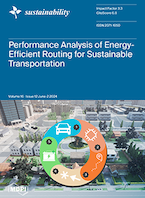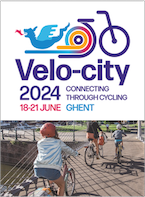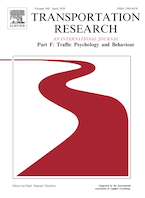Search result67 results
-

Why frequent traffic accidents at highway tunnel exit? – An experimental analysis of the slack effect
Yongzheng Yang, Zhigang Du, Francisco Alonso, Mireia Faus, Shiming He
(2024). ArticleTunnelling and Underground Space Technology. No.152:105927
This study analyzes the causes of frequent traffic accidents at the exit areas of highway tunnels. Vehicle experiments were conducted to collect data on the light environment, vehicle speed, and driver eye movement. The distribution patterns of the illumination, vehicle speed, and gaze location occupancy were analyzed, and highway tunnels of different lengths were compared. The tunnel exit area is divided into the transition, exit, and departure zones. It was observed that there was an obvious white-hole effect at the exit zone, with drastic changes in the light environment. The presence of abnormal acceleration behavior in the transition zone and decreased attention in the departure zone...
This study analyzes the causes of frequent traffic accidents at the exit areas of highway tunnels. Vehicle experiments were conducted to collect data on the light environment, vehicle speed, and driver eye movement. The distribution patterns of the illumination, vehicle speed, and gaze location occupancy were analyzed, and highway tunnels of different lengths were compared. The tunnel exit area is divided into the transition, exit, and departure zones. It was observed that there was an obvious white-hole effect at the exit zone, with drastic changes in the light environment. The presence of abnormal acceleration behavior in the transition zone and decreased attention in the departure zone demonstrate the existence of psychological and physiological slack in drivers. Additionally, the tunnel length positively correlates to the slack effect, which is stronger in extra-long tunnels than in the short and medium tunnels. Multiple control scenarios were established and driving simulation experiments were conducted to further analyze the impact of the slack effect on the traffic safety. The experimental results demonstrated that the slack effect of the extra-long tunnels exhibited an evident lag which was still present after leaving the tunnel exit. The average vehicle speed and trajectory offset were larger and more discrete in the post-tunnel zone than on an ordinary open road. The speed of the curve in the post-tunnel zone is 5.1 % higher than that of the curve in the ordinary road, and the maximum trajectory offset is 54.3 % higher. Thus, this study reveals the slack effect at tunnel exits and explains the abnormal phenomenon of relatively good traffic environments but high traffic accident rates in the transition and departure zones of tunnel exits. These results present considerable practical significance for the safe operation of highway tunnels, particularly extra-long tunnels.
Read more Hide DOI: 10.1016/j.tust.2024.105927ISSN: 1878-4364 -

Analysis of Commuting Habits and Perceived Risks: An Empirical Case Study in a Large Spanish Company
Cosme Fernández, Francisco Alonso, Francisco Tortosa, Mireia Faus
(2024). ArticleSustainability. No.16(12):5245
Commuting road accidents have a direct impact on workers as well as companies. Therefore, analyzing the characteristics of commuting to and from work and workers’ perceptions of their potential risk is necessary. This study analyzes these factors in a sample of employees in a large Spanish company. A questionnaire was distributed to a total of 665 workers, assessing variables such as means of transport used and preferred in this type of commuting, perceived risks, assessment of preventive measures, involvement in a road accident during commuting, and road safety training received by the company, among others. There is a difference between preferred and used modes of transport, with factors...
Commuting road accidents have a direct impact on workers as well as companies. Therefore, analyzing the characteristics of commuting to and from work and workers’ perceptions of their potential risk is necessary. This study analyzes these factors in a sample of employees in a large Spanish company. A questionnaire was distributed to a total of 665 workers, assessing variables such as means of transport used and preferred in this type of commuting, perceived risks, assessment of preventive measures, involvement in a road accident during commuting, and road safety training received by the company, among others. There is a difference between preferred and used modes of transport, with factors limiting the use of soft modes. People who have experienced an accident on the way to work have a higher risk perception of this type of journey. The time and distance of the journey also have a significant influence on the perceived risk. The most highly rated preventive actions are mainly related to the accessibility and comfort of the workers’ daily commute, which helps minimize the time spent on journeys. This analysis provides relevant information on the social acceptability of different measures for the development and implementation of future actions of the prevention services that contribute to reducing this type of accident and designing strategies to promote more sustainable commuting mobility.
Read more Hide DOI: 10.3390/su16125245ISSN: 2071-1050 -

Velo-city 2024
Sergio Useche, Francisco Alonso, Mireia Faus
(2024). Participació en congressosDrs. Sergio Useche, Francisco Alonso and Mireia Faus are participating in the Velo-city 2024 Congress, to be held from June 18-21, 2024 in Ghent (Belgium), with the poster presentation “Better late than tomorrow”: Relationships between cycling enrollment ages, health-related expectations, and riding outcomes:A cross-cultural study. Velo-city is the yearly flagship event of the European Cyclists' Federation and it is co-organised with a different city every year. Velo-city is where advocates, cities, policy makers, researchers and industry leaders meet to shape the future of cycling and sustainable urban development. Velo-city conferences are now attracting about 1,500 delegates from more...
Drs. Sergio Useche, Francisco Alonso and Mireia Faus are participating in the Velo-city 2024 Congress, to be held from June 18-21, 2024 in Ghent (Belgium), with the poster presentation “Better late than tomorrow”: Relationships between cycling enrollment ages, health-related expectations, and riding outcomes:A cross-cultural study. Velo-city is the yearly flagship event of the European Cyclists' Federation and it is co-organised with a different city every year. Velo-city is where advocates, cities, policy makers, researchers and industry leaders meet to shape the future of cycling and sustainable urban development. Velo-city conferences are now attracting about 1,500 delegates from more than 60 different countries. As the flagship event of the European Cyclists’ Federation, Velo-city plays a vital role in promoting cycling as a sustainable and healthy means of transport for all.
Read more Hide -

Traveling Together: Modelling the future of sustainable urban mobility
Francisco Alonso
(2024). Participació en congressosDr. Francisco Alonso, Director of INTRAS, has participated in the 1st CIVINET Technical Visit “Traveling Together: Modelling the future of sustainable urban mobility", held on June 17 and 18, 2024 in Barcelona. Dr. Alonso has been part of the round table “Persistence: Making the car a problem of the past” from the approach “Sharing failure stories of policies or projects that failed in reducing car use”. This technical visit promotes knowledge sharing and is dedicated to shaping the future of sustainable urban mobility, making it a priority while exploring sustainable transport solutions that reduce car dependency. Participants have discussed key issues and solutions, fostering a space...
Dr. Francisco Alonso, Director of INTRAS, has participated in the 1st CIVINET Technical Visit “Traveling Together: Modelling the future of sustainable urban mobility", held on June 17 and 18, 2024 in Barcelona. Dr. Alonso has been part of the round table “Persistence: Making the car a problem of the past” from the approach “Sharing failure stories of policies or projects that failed in reducing car use”. This technical visit promotes knowledge sharing and is dedicated to shaping the future of sustainable urban mobility, making it a priority while exploring sustainable transport solutions that reduce car dependency. Participants have discussed key issues and solutions, fostering a space for technology knowledge transfer and collaboration.
Read more Hide -

Public Transportation Means as seen by Citizens: approaching the case of the Dominican Republic
Francisco Alonso, Cristina Esteban, Mireia Faus, Sergio Useche
(2024). ArticleHeliyon. No.10:e32363
Especially in low and middle-income countries, key constraints such as dense traffic flows, jams, and pollution constitute frequent issues that potentially explain many negative consequences in terms of (e.g.) efficiency, sustainability, and mobility safety. In this regard, recent evidence supports the idea that fostering public transportation is crucial to offering solutions for this difficult panorama. However, transport mode-related choices and shifts have been proven to depend highly on key perceptions and needs of potential users. The aim of this study was to analyze a set of key users’ perceptions, usage, and perceived quality of public transportation in the Dominican Republic, as...
Especially in low and middle-income countries, key constraints such as dense traffic flows, jams, and pollution constitute frequent issues that potentially explain many negative consequences in terms of (e.g.) efficiency, sustainability, and mobility safety. In this regard, recent evidence supports the idea that fostering public transportation is crucial to offering solutions for this difficult panorama. However, transport mode-related choices and shifts have been proven to depend highly on key perceptions and needs of potential users. The aim of this study was to analyze a set of key users’ perceptions, usage, and perceived quality of public transportation in the Dominican Republic, as well as to explore the most relevant features for Dominicans from the “desired quality” paradigm. For this research at a national level, data retrieved from a nationwide sample of 1254 inhabitants of the Dominican Republic was used, proportional to the ONE census in terms of sex, age, habitat, and region. Overall, the results show that the general quality of transportation is 6.70 points out of 10. The use of public transportation in the Dominican Republic has a medium-low rating and is very focused on urban buses (41 %) and public cars (27.1 %). Nonetheless, the metro remains the most highly rated means of transport (M = 8.75). Concerning the quality variables analyzed, the highest scores are for accessibility (M = 7.08) and frequency of service (M = 6.99). Further, Dominicans focus on improving comfort, vehicle conditions, and safety. This study constitutes a first approximation to the desired quality of public transportation for Dominican Citizens, which may help policymakers scope user-based needs in public transportation systems and encourage a more frequent (and friendlier) public transport use in the country.
Read more Hide DOI: 10.1016/j.heliyon.2024.e32363ISSN: 2405-8440 -

RECOSEVIAL/XII
Francisco Alonso
(2024). Participació en congressosDr. Francisco Alonso, Director of INTRAS, participated in the National Congress of Driver Recognition Centers for Road Safety, RECOSEVIAL/XII, which was held in Lanzarote from May 2 to 4, 2024. After the opening ceremony, Dr. Alonso presented the conference "The future of research and practice on Road Safety", in which he related a whole series of emerging issues including epidemiological ones, as well as drawing the map of future ones, explaining certain methodological and technological developments. Likewise, Alonso has exposed the practical implications that all this could entail, focusing on what refers to the "human factor" as a major explanatory factor of traffic accidents, trying to...
Dr. Francisco Alonso, Director of INTRAS, participated in the National Congress of Driver Recognition Centers for Road Safety, RECOSEVIAL/XII, which was held in Lanzarote from May 2 to 4, 2024. After the opening ceremony, Dr. Alonso presented the conference "The future of research and practice on Road Safety", in which he related a whole series of emerging issues including epidemiological ones, as well as drawing the map of future ones, explaining certain methodological and technological developments. Likewise, Alonso has exposed the practical implications that all this could entail, focusing on what refers to the "human factor" as a major explanatory factor of traffic accidents, trying to generate a certain coping strategy.
Read more Hide -

How to resolve the contradiction between driving safety and lighting energy conservation in a highway tunnel? − An experiment on linear guiding system
Yongzheng Yang, Francisco Alonso, Zhigang Du, Sergio Useche
(2024). ArticleTransportation Research Part F: Traffic Psychology and Behaviour. No.103:319-339
High rates of traffic accidents and lighting energy consumption are significant problems in highway tunnels. To address these problems, this study proposes a linear guiding system that uses line-shaped visual guiding facilities to improve the local luminance and contrast, and outlines the tunnel contour and road alignment. In addition, the principle, function, setting method, and composition of the linear guiding system are discussed. Using the existing highway tunnels as prototypes, we built simulation scenarios with different luminance and conducted driving simulation experiments and questionnaire surveys. We analysed the human factor demands of tunnel driving, studied the change rule of...
High rates of traffic accidents and lighting energy consumption are significant problems in highway tunnels. To address these problems, this study proposes a linear guiding system that uses line-shaped visual guiding facilities to improve the local luminance and contrast, and outlines the tunnel contour and road alignment. In addition, the principle, function, setting method, and composition of the linear guiding system are discussed. Using the existing highway tunnels as prototypes, we built simulation scenarios with different luminance and conducted driving simulation experiments and questionnaire surveys. We analysed the human factor demands of tunnel driving, studied the change rule of various human factor indicators under different luminance levels, and comprehensively evaluated the impact of linear guiding system on driving safety from multiple perspectives of the driver’s vision, psychology, and behaviour. We introduce the concept of equivalent luminance, quantify the impact of linear guiding system on the driver, and explore the role of linear guiding system in energy conservation. The results showed that the linear guiding system has a positive effect on driver vision, psychology, and behaviour, particularly in low-luminance environments. A linear guiding system can optimise a driver’s visual reference frame, enhance driver visual perception in a tunnel environment, and alleviate driver tension. It helps drivers to accurately perceive their own spatial position and speed, providing a good sense of position, speed, and comfort. A 2.3 cd/m2 luminance highway tunnel with a linear guiding system is equivalent to a 4 cd/m2 luminance traditional tunnel. For highway tunnels with luminance values of 4, 5, 6, and 7 cd/m2, the equivalent luminance values of the linear guiding system are 1.7, 1.8, 1.8, and 2.1 cd/m2 respectively, which can reduce the energy consumption by 30–42 %
Read more Hide DOI: 10.1016/j.trf.2024.04.018ISSN: 1369-8478 -

Sustainable behavior begins with sustainable attitudes: Data to assess the relationships between demographics, concerns about transport-related pollution, and willingness for action
Francisco Alonso, Cristina Esteban, Mireia Faus, Sergio Useche
(2024). ArticleData in Brief. No.54:110446
This Data in Brief (DiB) article addresses the relationships among individuals’ transport habits, perceptions, and attitudes regarding transport-related pollution, as well as their willingness to act for environmental change. There are presented descriptive statistics, basic comparisons, and bivariate correlations among the core variables of the study. Additionally, the attached dataset appends information from a nationwide sample of 1,250 citizens in the Dominican Republic, with sex, age and habitat distribution proportional to the national census. The research database contains the full set of questions and responses to the research questionnaire, which is also attached to the...
This Data in Brief (DiB) article addresses the relationships among individuals’ transport habits, perceptions, and attitudes regarding transport-related pollution, as well as their willingness to act for environmental change. There are presented descriptive statistics, basic comparisons, and bivariate correlations among the core variables of the study. Additionally, the attached dataset appends information from a nationwide sample of 1,250 citizens in the Dominican Republic, with sex, age and habitat distribution proportional to the national census. The research database contains the full set of questions and responses to the research questionnaire, which is also attached to the supplementary files along with its codebook, making it possible to conduct further data explorations for research-related, divulgation, and educational purposes. For more information about the root study, it is advisable to read the paper “Who wants to change their transport habits to help reduce air pollution? A nationwide study in the Caribbean”, published in Journal of Transport & Health [1].
Read more Hide DOI: 10.1016/j.dib.2024.110446ISSN: 2352-3409 -

24th Spanish Congress ITS
Francisco Alonso
(2024). Participació en congressosDr. Francisco Alonso, Director of INTRAS, has participated in the 24th Spanish ITS Congress, which was held from April 23rd to 25th, 2024. Dr. Alonso has presented the conference entitled "Efficient solution for the training of professionals in the ITS sector: ITS Diploma", in which he has exposed the types of training, the needs, with the analysis of the existing offer and consequent deficits, and the offer and proposals from ITS Spain/ITS Iberoamerica. The slogan of this year's Congress "ITS as a Key Instrument for the Digitalization of Mobility" is in line with the reality that we continue with the thriving, even thundering, momentum that ITS are experiencing, thanks to the momentum of...
Dr. Francisco Alonso, Director of INTRAS, has participated in the 24th Spanish ITS Congress, which was held from April 23rd to 25th, 2024. Dr. Alonso has presented the conference entitled "Efficient solution for the training of professionals in the ITS sector: ITS Diploma", in which he has exposed the types of training, the needs, with the analysis of the existing offer and consequent deficits, and the offer and proposals from ITS Spain/ITS Iberoamerica. The slogan of this year's Congress "ITS as a Key Instrument for the Digitalization of Mobility" is in line with the reality that we continue with the thriving, even thundering, momentum that ITS are experiencing, thanks to the momentum of the EU Next Generation funds, which at least will remain so until the end of 2025. This can be seen in the different areas of ITS: public transport, urban mobility, data and models for mobility, etc.
Read more Hide -

The Role of News Media in Reducing Traffic Accidents
Antonio J. Lucas, Francisco Alonso, Mireia Faus, Arash Javadinejad
(2024). ArticleSocieties. No.14(5):56
Traffic accidents represent a major problem worldwide. Public and private entities launch communication campaigns in order to educate the population about this problem. The aim of this study is to analyze the evolution of the presence of road safety in the Spanish media and its influence on the reduction of road accidents. A content analysis of six major Spanish newspapers between 2000 and 2008 (an important period in the reduction of the accident rate in Spain) was carried out in which the presence of news related to traffic accidents and the intensity of them were quantified using a set of criteria designed for this study. Furthermore, the correlation between the accident rates and the...
Traffic accidents represent a major problem worldwide. Public and private entities launch communication campaigns in order to educate the population about this problem. The aim of this study is to analyze the evolution of the presence of road safety in the Spanish media and its influence on the reduction of road accidents. A content analysis of six major Spanish newspapers between 2000 and 2008 (an important period in the reduction of the accident rate in Spain) was carried out in which the presence of news related to traffic accidents and the intensity of them were quantified using a set of criteria designed for this study. Furthermore, the correlation between the accident rates and the presence and intensity of news in the same time frame was measured. There has been an evident increase in the news related to traffic accidents during the analyzed period, both in terms of the presence of such news in general and in terms of intensity. The correlation analysis also shows a strong relationship between the increase in news presence and intensity and a sharp fall in accident rates in Spain. Although correlation analysis is not enough to establish a causal relationship between the variables studied here, the findings suggest that informative campaigns had a positive effect on encouraging pro-social behavior, were successful in disseminating related information, and, therefore, contributed significantly to lowering accident rates, although that was not the only reason.
Read more Hide DOI: 10.3390/soc14050056ISSN: 2075-4698









